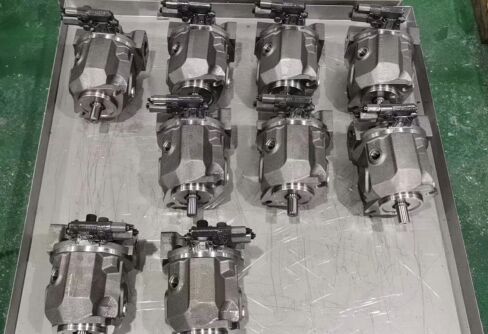The main performance parameters of hydraulic pump and hydraulic motor classification
The main performance parameters of hydraulic pump and hydraulic motor classification
Hydraulic motor: the energy imported into the motor or other engine into the liquid pressure energy, to the system oil supply hydraulic motor: the pump input hydraulic energy into mechanical energy and do work on the load hydraulic motor and hydraulic motor function hydraulic motor: the energy imported into the motor or other engine into the liquid pressure energy, to the system oil supply.

Hydraulic motor: the pump input hydraulic energy into mechanical energy and do work on the load Function - opposite Structure - similar Principle - reciprocal The basic principle of hydraulic motor Suction: seal volume increases, generating vacuum Pressure: seal volume decreases, the oil is forced to press out The basic working conditions of hydraulic motor ( (necessary conditions) 1 to form a sealed volume hydraulic piston pump 2 seal volume change 3 suction and pressure oil cavity separation (flow distribution device) according to the structure: gear type vane type plunger type can be changed according to the direction of oil delivery: one-way and two-way: according to the use of pressure: low pressure medium pressure medium and high pressure high pressure hydraulic motor and hydraulic motor of the main operating parameters working pressure and rated pressure, displacement and flow rate, power and efficiency, efficiency working pressure is the actual work of the pump (or motor) output (or motor). (or motor) the actual work of the output (or into) the oil pressure, its value depends on the external load: pipe resistance, friction, external load *) rated pressure is the pump (or motor) in normal operating conditions under continuous operation of the highest pressure (subject to pump (or motor) leakage and structural strength limitations) p>pn that pump overload maximum allowable pressure hydraulic piston pump: pump (or motor) allowed in a short period of time overload use ( pmax) limit pressure p ≤ pn ≤ pmax displacement - the volume of liquid discharged from the pump (or motor) each week, without leakage.
Theoretical flow qt: the volume of liquid discharged per unit of time without regard to leakage qt = Vn Actual flow q: the actual output of the pump (or motor) when working q = qt - qs Rated flow (nominal flow, nameplate flow) qn: refers to the pump under normal operating conditions, according to the test standard must ensure the output flow.
q ≤ qn ≤ qt Instantaneous flow: the geometric flow of the pump at a certain instant Theoretical power: Pt = pqt Import (or output) power: the pump shaft drive power or motor output power PI = ωT = 2πnT hydraulic piston pump Output (or import) power: PO = pq Conclusion: the power of the hydraulic transmission system fluid, that is, hydraulic power is equal to If energy losses are ignored, the product of pressure and flow PO = PI , i.e. Pt=pqt=pVn=ωTt=2πnTt ∵ There is actually energy loss ∴ PO volumetric efficiency Hydraulic motor: the ratio of actual flow to theoretical flow ηv=q/qi=(qi-qs)/qi=1-qs/qi Hydraulic motor: the ratio of theoretical flow to actual flow ηv=qi/q=1-qs/q Mechanical efficiency Hydraulic motor: the ratio of theoretical torque to actual imported torque Hydraulic motor: ratio of theoretical torque to actual introduced torque ηm=Ti/T=1+Ts/Ti Hydraulic motor: ratio of theoretical torque to actual introduced torque of hydraulic piston pump ηm=T/Ti=(Ti-Ts)/Ti=1-Ts/Ti Total efficiency Ratio of output power to input power η=P0/Pi=Pq/2πnT=Pvnηv/2πnT=ηvηm Conclusion: Total volume efficiency is equal to the product of volume efficiency and the product of mechanical efficiency.
This article is published by the official website of Baolilai Hydraulics, please contact the author and indicate the source for reprinting:https://www.baolilai-pump.cn/news/312.html






